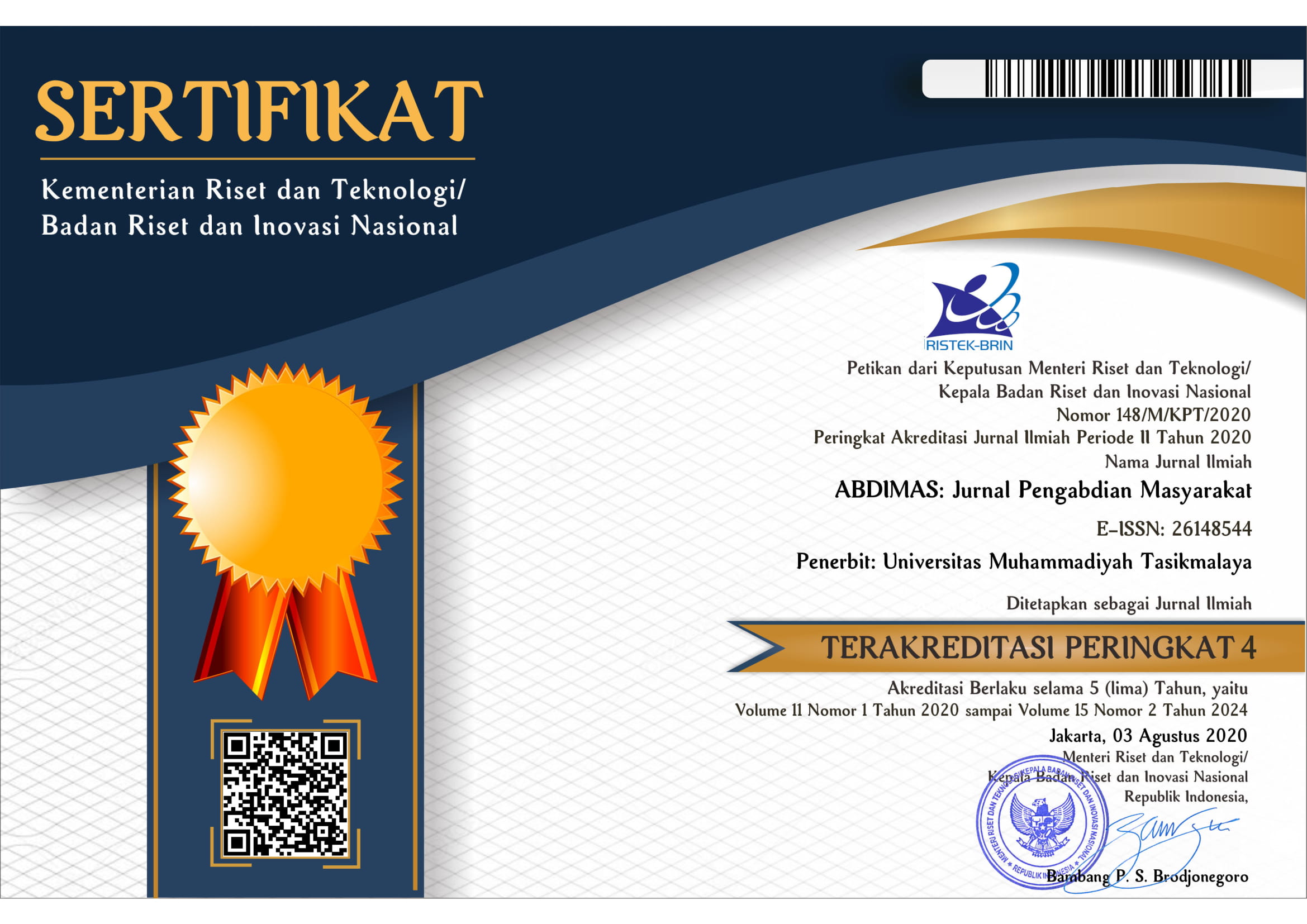Improving Students' Public Speaking Skills Using the Drill Method
DOI:
https://doi.org/10.35568/abdimas.v7i1.4272Keywords:
Drill method, Public speaking, Asset Based Community, DevelopmentAbstract
Public speaking or public speaking skills are one of the most essential language skills to master, including for junior high school level students. This is because speaking skills are beneficial for expressing oneself, such as conveying thoughts and ideas according to the goals you want to achieve. However, many students still need good public speaking, including students at Mts Walisongo 2. Community service activities are carried out at Mts Walisongo 2 in Sukomakmur Village, Kajoran District, using the Asset Based Community Development (ABCD) approach. The service team used the drill learning method to improve students' public speaking skills in carrying out the activities. This mentoring was implemented successfully and significantly impacted the public speaking skills of Mts Walisongo 2 students.
Downloads
References
Afifah, N., & Asnah, M. B. (2021). Meningkatkan Keterampilan Toilet Training Melalui Metode Latihan bagi Anak Autis. Edumaspul: Jurnal Pendidikan, 5(2), 679–684. https://doi.org/10.33487/edumaspul.v5i2.2240
Anggriani, D., Hamima, N. W., Azka, K. F. L., & Umara, N. S. (2022). Mengembangkan Keterampilan Berbicara Dan Rasa Percaya Diri Melalui Public Speaking Bagi Anak Panti Asuhan Wisma Karya Bakti. Seminar Nasional Pengabdian Masyarakat LP UMJ, 3(2), 1–6. Retrieved from http://jurnal.umj.ac.id/index.php/semnaskat
Aniar Hari Swasono, M., Immatus Sa’diyah, A., Eka Nia Fitri, R., & Hidayanti, R. (2020). Membangun Kebiasaaan Membaca pada Anak di masa Pandemi Covid-19 melalui Program Satu Jam Tanpa Gawai di Griya Baca Desa Karangrejo. Jurnal Pengabdian Masyarakat, 1(2), 38–50.
Artiasih, N. M. (2022). Metode Drill Sebagai Upaya Meningkatkan Hasil Belajar Matematika Siswa Kelas VI Sekolah Dasar. Journal of Education Action Research, 6(3), 396–402.
Atmi, B. A. O. W., & Pharhyuna, K. A. J. (2019). Improving Speaking Skill By Using Drill Technique At the Tenth Grade Students of Smkn 1 Singaraja in Academic Year 2018/2019. Jurnal IKA, 16(2), 106–123. https://doi.org/10.23887/ika.v16i2.19830
Harrison, R., Blickem, C., Lamb, J., Kirk, S., & Vassilev, I. (2019). Asset-Based Community Development: Narratives, Practice, and Conditions of Possibility A Qualitative Study With Community Practitioners. SAGE Open, 9(1). https://doi.org/10.1177/2158244018823081
Hasyim, M., & Irwan, D. W. (2014). Pelatihan Public Speaking Pada Remaja dan Anak-Anak Dusun Puluhan, Desa Banyusidi, Pakis, Magelang, Jawa Tengah. Jurnal Inovasi Dan Kewirausahaan, 3(2), 96–100.
Khetaguri, T., & Albay, M. (2016). The Use of Drills in the Development of Speaking Skills. International Journal of Social Sciences & Educational Studies, 3(1), 54–58. Retrieved from https://search.proquest.com/openview/a49cff0be78a11f87cbdd7ef09e9d4d0/1?pq-origsite=gscholar&cbl=4672073
Khrisna Sawitri, D., Handayani, W., Korika Swasti, I., Anggitasari, D., Kalitdyah, F., & Aini Rahmaniah, N. (2022). Communication Skill Training of Bunda PAUD at Pakal Surabaya to Meet the Competency as Professional Educator. Jurnal Pengabdian Kepada Masyarakat, 5(2).
Lutfiyatun, E., Shahab, A., Mulyadi, A. I., & Kurniati, D. (2023). the Drilling Method To Enhance Students’ Public Speaking At Tahfidz Takhassus Daarul Qur’an Islamic Boarding School Palembang. Dialectical Literature and Educational Journal, 8(1), 1–10. https://doi.org/10.51714/dlejpancasakti.v8i1.95.pp.1-10
Ma’ruf, M. A., & Purwanto. (2021). Pendampingan dalam meningkatkan kemampuan public speaking santri di pondok pesantren Mamba’ul Huda Kaliabu. Khidmatan, 1(1), 9–14.
Mardiana, I. N. (2022). Metode Drill untuk Meningkatkan Hasil Belajar Penjasorkes pada Siswa Kelas VI SD. Journal of Education Action Research, 6(2), 182–187. https://doi.org/10.23887/jear.v6i2.45821
Putri, H. R. (2022). The Effectiveness of Teaching Speaking by Using Drilling Method through YouTube. Journal of English Teaching, Literature, and Applied Linguistics, 6(2), 70. https://doi.org/10.30587/jetlal.v6i2.4069
Rafiq, A. (2020). Dampak Media Sosial terhadap Perubahan Sosial Suatu Masyarakat. Global Komunika, 1(1).
Selwen, P., Lisniasari, L., & Rahena, S. (2021). Pengaruh Kepercayaan Diri Terhadap Kemampuan Public Speaking Mahasiswa. Jurnal Pendidikan Buddha Dan Isu Sosial Kontemporer (JPBISK), 3(2), 63–69. https://doi.org/10.56325/jpbisk.v3i2.46
Stuart, G. (2013). What is Appreciative Inquiry? Retrieved January 2, 2024, from https://sustainingcommunity.wordpress.com/2013/11/21/what-is-appreciative-inquiry/
Sutini, Indayati, T., Hasan, A., & Chasanah, U. (2020). Modul Pelatihan Pembelajaran Berbasis Literasi dengan Pendekatan ABCD (Rakhmawati & A. Prasetyo Kurniawan, Eds.). Surabaya: Kanzum Books.
Syazali, M., Olivia, N., & Sobri, M. (2023). Upaya Meningkatkan Keterampilan Public Speaking. El-Hikam: Jurnal Kajian Pendidikan Dan Keagamaan, 16(1), 71–82.
Tohani, E., & Lestari, D. D. (2022). Development of Youth Soft Skill in Organizations Through Basic Public Speaking Training. ABDIMAS: Jurnal Pengabdian Masyarakat, 5(1), 1824–1829.
Verrawati, A. J., Wuryandani, W., & Sugiarsih, S. (2022). Drill Method: Improving Reading Aloud Skills? Proceedings of the 5th International Conference on Current Issues in Education (ICCIE 2021), 640(Iccie), 318–322. https://doi.org/10.2991/assehr.k.220129.058
Yuliantoro, P., Heryana, N., & Syambasri. (2019). Peningkatan Kemampuan Berpidato dengan Menerapkan Pendekatan Komunikatif dan Metode Latihan pada Siswa SMP. Khatulistiwa, 8(11), 1–9.














